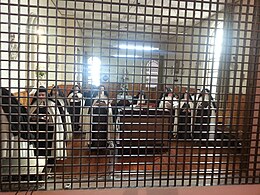Enclosed religious orders


Enclosed religious orders or cloistered clergy are
Under certain circumstances, exceptions may be granted for enclosed men or women to leave the enclosure temporarily or permanently.
Enclosed religious orders of men include
nuns and the Monastic Family of Bethlehem.Contemplative orders
The English word
Although the English word
Exclaustration
In the Roman Rite of the Catholic Church, once a man or woman has made solemn, perpetual religious vows, the release from these monastic vows has to be approved by the ecclesiastical authorities. Normally there is a transitional period, called exclaustration, in which the person looks to establish a new life and determine if this is what he or she is truly called to do. This usually lasts up to six years under the 1983 Code of Canon Law. After this period the appropriate authority, generally the Holy See, determines that the wish to leave a religious life is valid and grants the former monk or nun release from their vows.
Monastic life
Contemplative orders prioritise worship and prayer over economic or outreach activity.[5][6] They exist in the Roman Catholic, Anglican and Eastern Orthodox traditions as well as in Buddhist settings.[7][8]
See also
References
- ^ VATICAN: Verbi Sponsa - Instruction on the Contemplative Life and on the Enclosure of Nuns
- ^ The Code of Canon Law, Canon 667 ff. English translation copyright 1983 The Canon Law Society Trust "Code of Canon Law Index". Archived from the original on 19 June 2006. Retrieved 17 June 2006.
- ^ Codex Iuris Canonici Can. 637, § 4
- ^ Saunders, William (2003). "The Meaning of the Terms Nun, Sister, Monk, Priest, and Brother". Catholic Education Resource Center. Retrieved 28 May 2018.
- ^
Schadé, Johannes P. (2006). Encyclopedia of World Religions. Foreign Media Group. p. 220. ISBN 978-1-60136-000-7. Retrieved 8 January 2011.
Contemplative Order[: ] A religious community which engages exclusively, or almost exclusively, in activities directly ordered to contemplation.
- ^
Gurdon, Edmund (1908). "Contemplative Life". The Catholic Encyclopedia, volume 4. New York: Robert Appleton Company. Retrieved 8 January 2011.
The great function assumed by contemplatives [...] is the worship of God.
- ^
Bishop, George B. H. (2007). The Religion of Russia: A Study of the Orthodox Church in Russia from the Point of View of the Church in England. Gorgias Press LLC. p. 40. ISBN 978-1-59333-566-3. Retrieved 8 January 2011.
The rich variety of religious orders existing in Western Christendom finds no parallel in the Orthodox Church, where there is but one, the contemplative order of S. Basil.
- ^
Cooray, L. J. Mark (1971). The reception in Ceylon of the English trust: an analysis of the case law and statutory principles relating to trusts and trustees in Ceylon in the light of the relevant foreign cases and authorities. Lake House Printers and Publishers. p. 168. Retrieved 8 January 2011.
[...] a trust for a contemplative order of Buddhist nuns was upheld.
External links
- What is a Cloistered Nun? – AN INTRODUCTION TO CONTEMPLATIVE LIFE
- Cloistered contemplative monks – THE CONTEMPLATIVE MEN'S MONASTERIES
- New Advent Encyclopaedia on "Religious Life"
- New Advent Encyclopaedia III ff. on "Nuns, properly so called"
- Herbermann, Charles, ed. (1913). . Catholic Encyclopedia. New York: Robert Appleton Company.


